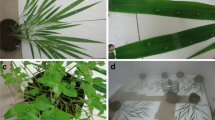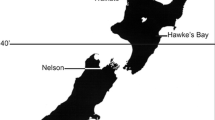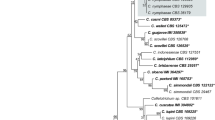Abstract
Leaves of sweet cherry, exposed to either paraquat or freezing to quickly senesce the leaf tissue, were incubated in about 100% RH at 25°C for 6 d. Sporulating colonies of Colletotrichum acutatum, the cause of anthracnose, developed on up to 100% of the paraquat-treated and frozen leaves, and on none of the untreated controls. Number of leaves and leaf area containing C. acutatum on naturally infected leaves increased over time from May to September. Mean incidence of C. acutatum on leaf blades on fruit spurs and vegetative shoots from eight orchard/year samplings were 41 and 33%, respectively. Secondary conidiation (formation of short hyphae and new conidia) from conidia applied to detached leaves took place 6 h after inoculation, but only up to 3% of the conidia formed new conidia. It may be concluded that asymptomatic sweet cherry leaves frequently host C. acutatum and may be a potential inoculum source for cherry fruit.




Similar content being viewed by others
References
Adaskaveg, J. E., & Hartin, R. J. (1997). Characterization of Colletotrichum acutatum isolates causing anthracnose of almond and peach in California. Phytopathology, 87, 979–987.
Ash, G. J., & Lanoiselet, V. M. (2001). First report of Colletotrichum acutatum causing a leaf spot and hull rot of pistachio. Australasian Plant Pathology, 30, 365–366.
Børve, J., & Stensvand, A. (2004). Non-abscised aborted sweet cherry fruits are vulnerable to fruit decaying fungi and may be sources of infection for healthy fruits. Acta Agriculturae Scandinavica, 54, 31–37.
Børve, J., & Stensvand, A. (2006a). Colletotrichum acutatum overwinters on sweet cherry buds. Plant Disease, 90, 1452–1456.
Børve, J., & Stensvand, A. (2006b). Timing of fungicide applications against anthracnose in sweet and sour cherry production in Norway. Crop Protection, 25, 781–787.
Cook, R. T. A. (1993). Strawberry black spot caused by Colletotrichum acutatum. In: D. Ebbels (ed.), Plant Health and the European Single Market. BCPC Monograph, 54, pp.301–304.
Crusius, L. U., Forcelini, C. A., Sanhueza, R. M. V., & Fernandes, J. M. C. (2002). Epidemiology of apple leaf spot. Fitopatologia brasileira, 27, 65–70.
Dieguez-Uribeondo, J., Förster, H., Soto-Estrada, A., & Adaskaveg, J. E. (2005). Subcuticular-intracellular hemibiotrophic and intercellular necrotrophic development of Colletotrichum acutatum on almond. Phytopathology, 95, 751–758.
EPPO (2004). Glomerella acutata. OEPP/EPPO Bulletin, 34, 193–199.
Leandro, L. F. S., Gleason, M. L., Nutter, F. W., Wegulo, S. N., & Dixon, P. M. (2001). Germination and sporulation of Colletotrichum acutatum on symptomless strawberry leaves. Phytopathology, 91, 659–664.
Leandro, L. F. S., Gleason, M. L., Nutter, F. W., Wegulo, S. N., & Dixon, P. M. (2003a). Influence of temperature and wetness duration on conidia and appressoria of Colletotrichum acutatum on symptomless strawberry leaves. Phytopathology, 93, 513–520.
Leandro, L. F. S., Gleason, M. L., Nutter, F. W., Wegulo, S. N., & Dixon, P. M. (2003b). Strawberry plant extracts stimulate secondary conidiation by Colletotrichum acutatum on symptomless leaves. Phytopathology, 93, 1285–1291.
Mertely, J. C., & Legard, D. E. (2004). Detection, isolation, and pathogenicity of Colletotrichum spp. from strawberry petioles. Plant Disease, 88, 407–412.
Stensvand, A., Talgø, V., Strømeng, G. M., Børve, J., Sletten, A., & Klemsdal, S. S. (2006). Colletotrichum acutatum in Norwegian strawberry production and sources of potential inoculum in and around strawberry fields. IOBC WPRS Bulletin, 29(9), 87–91.
Wharton, P. S., & Diéguez-Uribeondo, J. (2004). The biology of Colletotrichum acutatum. Anales del Jardin Botanico de Madrid, 61, 3–22.
Yoshida, S., & Shirata, A. (1999). The mulberry anthracnose fungus, Colletotrichum acutatum, overwinters on a mulberry tree. Annals of the Phytopathological Society of Japan, 65, 274–280.
Yoshida, S., & Tsukiboshi, T. (2002). Shoot blight and leaf spot of blueberry anthracnose caused by Colletotrichum acutatum. Journal of General Plant Pathology, 68, 246–248.
Zulfiqar, M., Brlansky, R. H., & Timmer, L. W. (1996). Infection of flower and vegetative tissue of citrus by Colletotrichum acutatum and C. gloeosporioides. Mycologia, 88, 121–128.
Acknowledgements
The Norwegian Ministry of Agriculture and Food supported the experiments financially.
The authors thank technicians at Ullensvang research centre for their help.
Author information
Authors and Affiliations
Corresponding author
Additional information
Børve, J., Djønne, R. T., and Stensvand, A. 20xx. Colletotrichum acutatum occurs asymptomatically on sweet cherry leaves. European Journal of Plant Pathology xx:0000-0000.
Rights and permissions
About this article
Cite this article
Børve, J., Djønne, R.T. & Stensvand, A. Colletotrichum acutatum occurs asymptomatically on sweet cherry leaves. Eur J Plant Pathol 127, 325–332 (2010). https://doi.org/10.1007/s10658-010-9597-x
Accepted:
Published:
Issue Date:
DOI: https://doi.org/10.1007/s10658-010-9597-x




